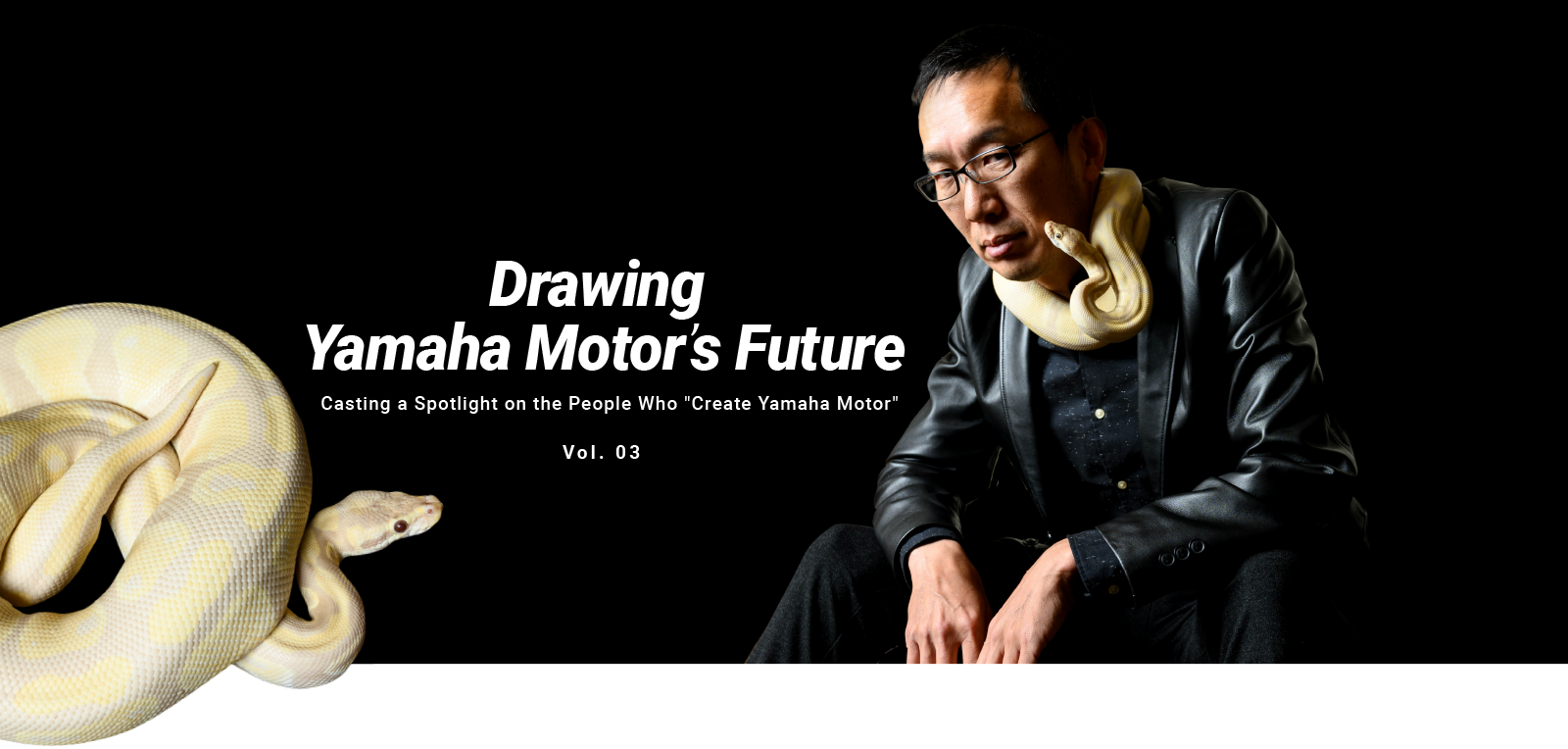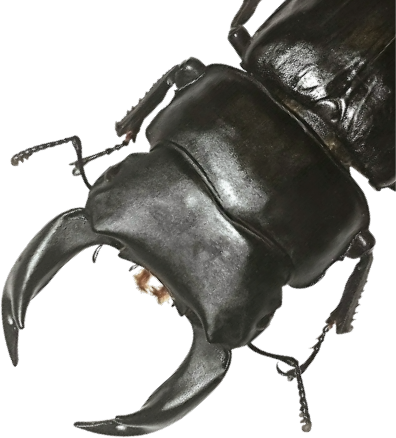

Leader of the MRS Product Design Group at the Design Center’s Frontier Design Division. Born in Saitama Prefecture. Majored in product design in university and joined Yamaha Motor after graduating. His current design work spans a diverse range of products, from boats and swimming pools to electrically power-assisted bicycles, golf carts and generators.
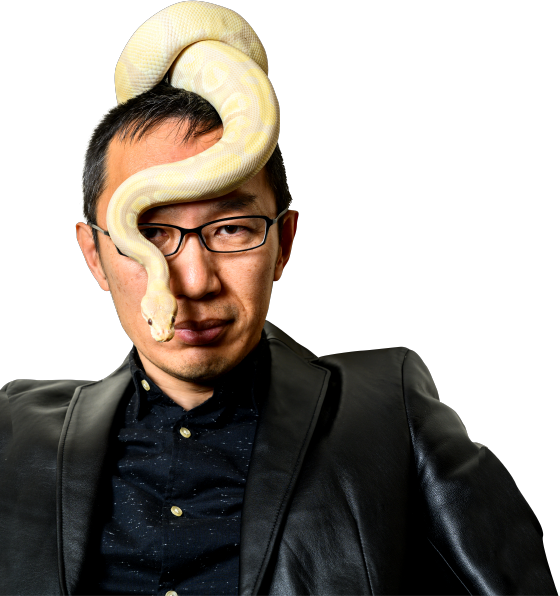

From the pictures for this third entry, some of you might think you’ve stumbled upon a rather peculiar website, but don’t worry. This somewhat shady-looking guy playing with a snake is a well-respected Yamaha Motor designer. Still, even within the Design Center, Ikuo Namiki has a reputation as an eccentric animal lover. The snake—a ball python—lives in Namiki’s home and he takes very good care of it. Included in his menagerie is a toy poodle, a turtle and a large collection of stag beetle specimens.
His first name of Ikuo literally means “a man who nurtures,” so true to his name, he has an unrivaled passion for raising and looking after animals. Namiki was born and raised in the countryside and grew up fishing, collecting insects and the like, fostering his love of animals and bugs. “There wasn’t much else to do out in the countryside, so we all played outside from morning till dusk. In particular, I became fascinated with collecting stag beetles. To young boys, no other insect embodies power and dynamism like the stag beetle. They’re special.”

After graduating from an art and design university, Namiki joined Yamaha and was involved in designing a variety of Yamaha products—from motorcycles to marine products—and was leading a fulfilling career. However, his life took an unexpected turn as the 21st century began, with the explosive popularity of an arcade and collectible card game released in the early 2000s called Mushiking: The King of Beetles. This set off a stag beetle boom in Japan and reignited Namiki’s youthful fascination with the insect. He started collecting and raising them with renewed passion, his interest utterly consuming him.
“I was breeding and collecting unusual varieties, and at one point I had about 300 of them. I even built a ‘stag beetle room’ at home where I could keep the temperature and humidity conditions controlled around the clock. I probably spent about two million yen on feed, the cages and electrical bills for running the AC! It was a lot of fun but staying on my wife’s good side wasn’t easy back then,” he says with a laugh. Namiki’s beetle farming undertaking ended as the popularity of Mushiking faded. The mass of beetles he so lovingly raised are now proudly displayed in cases in the living room. His latest pet is the snake shown in the photos, and while he only has one snake now, until recently he had as many as six, a situation the rest of the family frowned on.
So, what is it about living things that Namiki finds so fascinating? When I ask him, he removes one specimen from his vast collection and shows it to me. “The yellow wings on this Hercules beetle turn brown when the humidity increases. This occurs when water particles enter the small nooks on the surface of its wings and change their reflectivity.” To demonstrate, he began gently rubbing the wings of the specimen with a wet finger. Just as he said, the yellow wings began to darken slowly. “This is called iridescence or structural coloration and is in fact similar to the principles behind nano-film coatings,” he continues. His collection contains many stag beetles of different colors like green and yellow, but Namiki stated that the vibrant colors we see from light reflection due to structural coloration is only what we perceive with our eyes. “Regardless of their color, they all turn brownish when you put water or oil on them. Isn’t it fascinating? For me, stag beetles are a treasure trove for CMFG.*”
*Color, Material, Finish, Graphics

When Namiki mentions nano-film coatings, he’s referring to Yamaha’s proprietary SixONy coloring technology. As a very rudimentary explanation, the surface of the material is coated with a ceramic film only 20–80 nm thick. By controlling the film’s thickness and refraction of light in the process, a variety of different colors can be produced. This technology is already being used to coat the parts used on certain Yamaha motorcycles, and as shown below, it has also been used to produce colorful surfaces for wind instruments in a collaboration with musical instrument manufacturer, Yamaha Corporation. Applications for SixONy with many other types of products are anticipated. When Namiki attended the in-house technical presentations for SixONy, he came to a striking realization: “The latest coloring techniques and the structural coloration of the stag beetle work in essentially same way!”
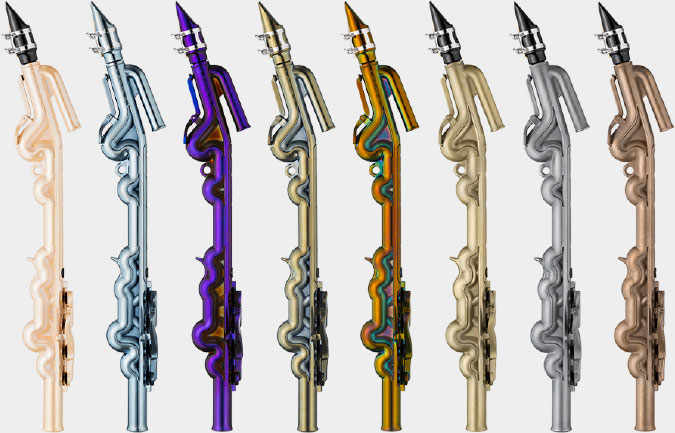
Namiki adds that stag beetles not only provide ideas for CMFG, but their unique shapes are also part of their allure. The world of stag beetles is profoundly diverse; their shapes not only change according to the species, but there are also slight differences even among the same species depending on where they can be found. “On top of being crazy about stag beetles, I’m also a product designer so I’m very finicky when it comes to the differences in forms and shapes,” he says with a chuckle. “So I can usually tell if a giant stag beetle is from Nirasaki in Yamanashi Prefecture, Kurume in Fukuoka Prefecture or some other place by looking at the shape of the jaws or the balance of proportions with the body.” Hearing this, I had to inquire if there were any product designs for which he had been inspired by the stag beetle. He replied that one was the 05GEN concept model; he was in charge of directing the design work. There surely were a good number of people who saw the shape of the roof on this short-range mobility vehicle, heard a stag beetle was the inspiration and thought “Ahh, okay, that makes sense!”
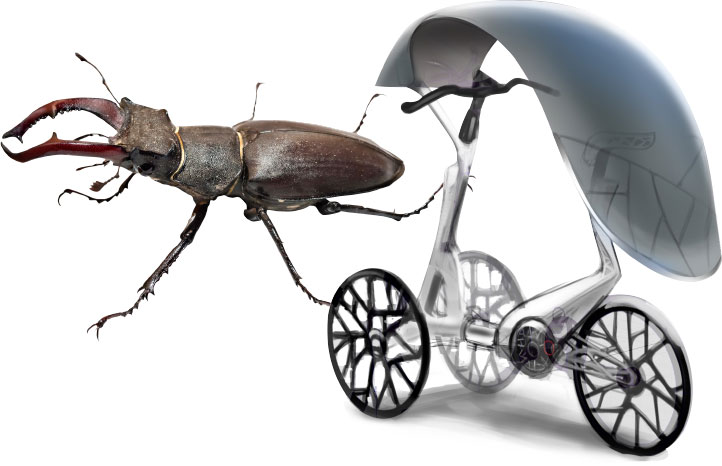
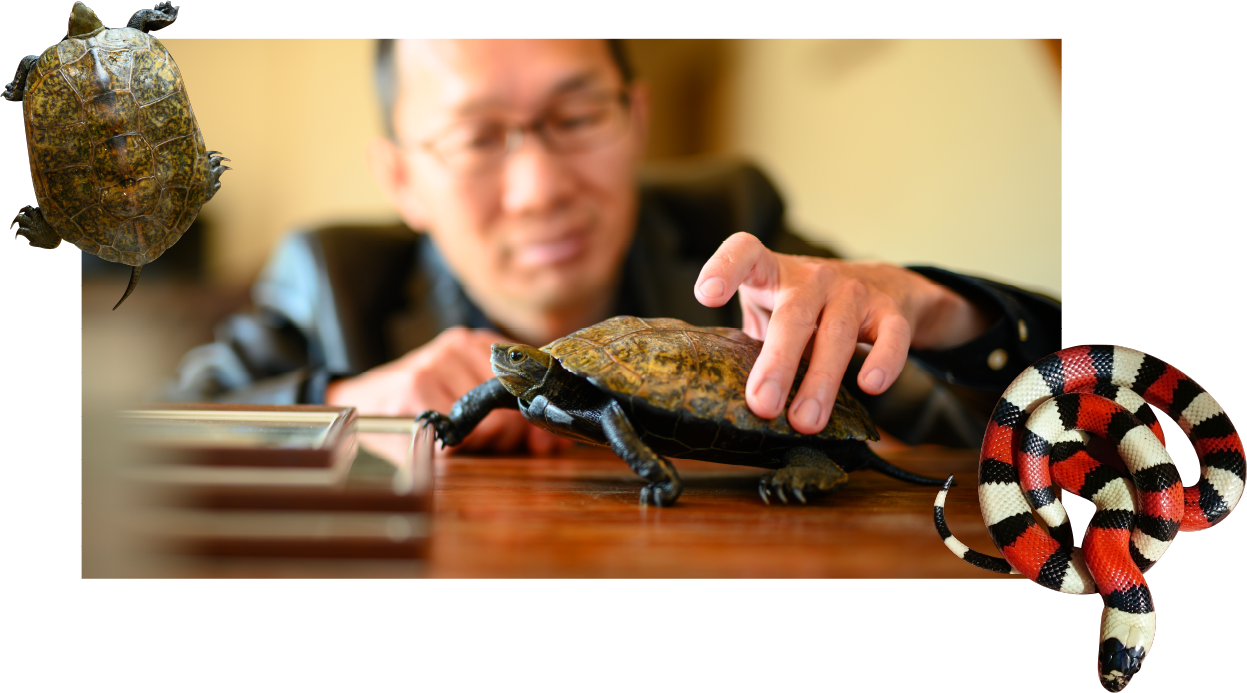
In addition to their habitat, lifespan and evolutionary characteristics significantly influence the shapes of stag beetles, explains Namiki. For example, when comparing the giant stag beetle with the Miyama stag beetle, the former has a flatter overall shape and thick, short legs. It has a relatively long lifespan of about five years because it has evolved to easily burrow into trees when hibernating for the winter. However, the Miyama stag beetle only lives for a year and so it has developed large three-dimensional jaws and long, thin legs so it can fight other males for mates.
“It’s even more interesting when you understand the reason why these creatures evolved the way they did. Stag beetles, snakes and turtles all evolved over thousands of years to have certain abilities and survival strategies, some of which directly manifest themselves in their colors and shape. From my perspective, they provide an abundance of hints for designs,” finishes Namiki.
His enthusiasm during our interview made it clear that the numerous Yamaha product designs Namiki has worked on are infused with his love and respect for living creatures.



